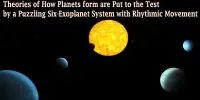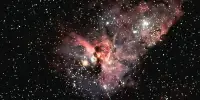If the mainstream model of cosmology is to be trusted, the James Webb Space Telescope (JWST) appears to be discovering many galaxies that grew too huge too soon after the Big Bang.
Mike Boylan-Kolchin, an associate professor of astronomy at The University of Texas in Austin, discovers in a paper published in Nature Astronomy that six of the earliest and most massive galaxy candidates discovered by JWST so far stand to defy prevailing cosmological thought.
This is due to the fact that some experts estimate that each galaxy is visible between 500 and 700 million years after the Big Bang and is more than 10 billion times as big as our sun.
One of the galaxies looks to be more massive than the Milky Way, despite the fact that our own galaxy formed and grew over billions of years.
“If the masses are right, then we are in uncharted territory,” Boylan-Kolchin said. “We’ll require something very new about galaxy formation or a modification to cosmology. One of the most extreme possibilities is that the universe was expanding faster shortly after the Big Bang than we predict, which might require new forces and particles.”
To create so quickly at such a large scale, galaxies would have to convert approximately 100% of their available gas into stars.
“We typically see a maximum of 10% of gas converted into stars,” Boylan-Kolchin said. “So while 100% conversion of gas into stars is technically right at the edge of what is theoretically possible, it’s really the case that this would require something to be very different from what we expect.”
If the masses are right, then we are in uncharted territory. We’ll require something very new about galaxy formation or a modification to cosmology. One of the most extreme possibilities is that the universe was expanding faster shortly after the Big Bang than we predict, which might require new forces and particles.
Mike Boylan-Kolchin
JWST, for all of its frenzied excitement, has confronted astronomers with an unpleasant quandary. If the masses and time since the Big Bang for these galaxies are confirmed, substantial revisions to the dominant model of cosmology, known as the dark energy + cold dark matter (ΛCDM) paradigm, which has driven cosmology since the late 1990s, may be required.
If there are additional, faster ways to produce galaxies than ΛCDM allows, or if more matter was accessible for generating stars and galaxies in the early universe than previously thought, astronomers may need to reconsider their current assumptions.
The dates and masses of the six galaxies are preliminary estimations that will need to be confirmed using spectroscopy, a technology that divides light into a spectrum and evaluates the brightness of different colors.
Such analysis could imply that central supermassive black holes, which could heat up the surrounding gas, are making galaxies brighter, making them appear more massive than they are.
Perhaps the galaxies are seen at a much later time than was previously estimated due to dust that causes the color of the light from the galaxy to shift redder, giving the illusion of being more lightyears away and thus further back in time.
The galaxy data came from the Cosmic Evolution Early Release Science Survey (CEERS), a multi-institution JWST initiative led by UT Austin astronomer Steven Finkelstein.
COSMOS-Web, a joint JWST project co-led by UT Austin’s Caitlin Casey, may be involved with spectroscopy and shining more light on the findings to help settle the quandary. COSMOS-Web is covering an area roughly 50 times larger than CEERS and is expected to discover thousands of galaxies.
“It will be ideal for discovering the rarest, most massive galaxies at early times, which will tell us how the biggest galaxies and black holes in the early universe arose so quickly,” Boylan-Kolchin said.
A team lead by Swinburne University of Technology in Australia revealed the initial discovery and estimates of the masses and redshifts of the six galaxy candidates in Nature in February.
The National Science Foundation and NASA support this research.
















